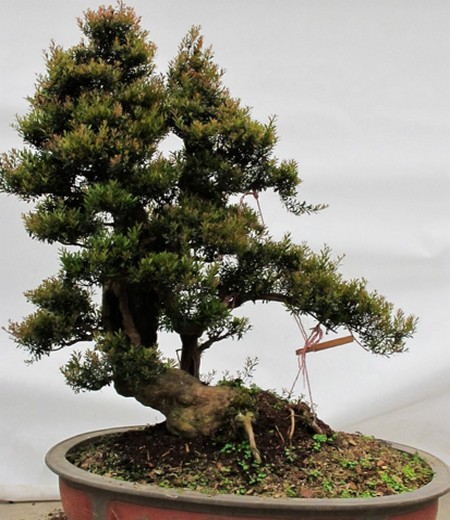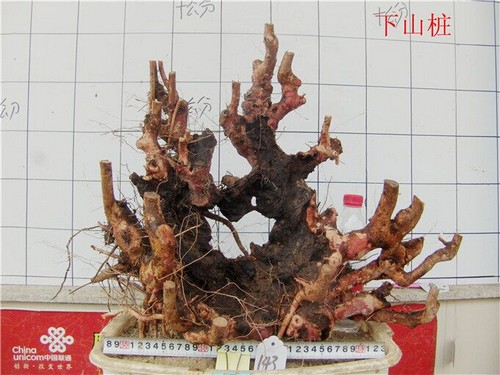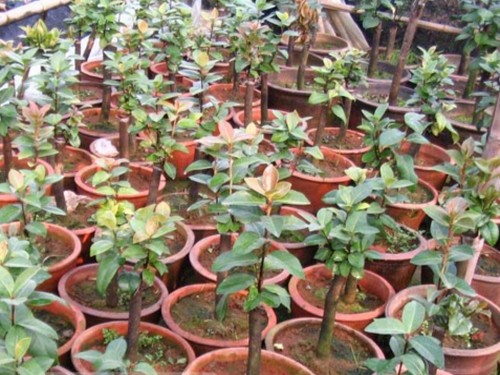Modeling method of bonsai pile
Chinan has become a good wood for bonsai production because of its dense branches, small leaves, green all the year round, strange pile shape, various shapes, staggered branches, strange roots, wide adaptability, easy management and so on. However, a perfect bonsai of Chinan must also rely on artificial artistic processing and trimming modeling, so that the pile scenery does not grow tall, not wild, and the shape is more perfect.

1. After the new buds germinate, remove the moss or straw that covers the old stakes and branches, so as not to affect the growth of the buds. At this time, the new root has not yet grown well, so it is necessary to strengthen water management and spray more water on tree stumps and branches to reduce foliar water evaporation. When new buds grow to 3cm-4cm, buds should be picked and unsuitable and overdense buds should be removed to ensure that the remaining buds grow and thrive. Picking buds can be divided into 2-3 times, and reserve buds should be left when picking buds for the first time to prevent accidental damage. The root system grows gradually after 2-3 months of germination, and can be transferred to a place where the sun can be exposed for 2 hours a day (except 11:00 to 3 pm), water is watered once in the morning and evening (except on rainy days), and more water is sprayed on tree stumps, branches and leaves. The root system of the newly planted stump is young, do not apply thick fertilizer, and it is better to apply thin fertilizer frequently.
2. After the excavated (or purchased) stump is cultivated in September, the extra branches will be cut off and the long branches will be cut short, so as to stimulate the growth of lateral buds under the shearing mouth, and urge the stump to send out 2murs three times a year, so as to increase the number of branches, shorten the distance between branches, and make the stump take shape as soon as possible, with an ancient posture. After the stump is formed, in order to maintain its beautiful shape, it is necessary to cut off too many dense branches, which is also conducive to the balance of nutrient supply and make the stump grow normally.
3. After the tree stump planted in spring survives, it can be thinned and fixed after the Mid-Autumn Festival, and the proportion of fertilizer and water can be gradually increased. The new bud germination rate of Cunninghamia lanceolata is high, and the whole body is covered with latent buds, so it is very convenient to choose and choose the location of bonsai branches. The required branches should be allowed to grow crazily until the second year the Beginning of Spring and then pruned, but the flowers should be removed in that year to avoid consuming nutrients.
4. The plastic binding of the Chinan stump is carried out after September, and the appropriate wire (thin bark, easy to be injured) is selected according to the thickness of the branches. Before binding the wire, roll paper outside the wire to avoid bark injury) or brown wire (brown rope). If the curved arc is large, it should be carried out for 3 times to prevent the branch from breaking or being injured too seriously and die; wrap moss, cloth or wet straw in the bend of the branch, and then often spray water to the bend to make the wound (injured tissue) heal as soon as possible and transport nutrients and water normally. In addition, the newly planted tree stump should not be tied prematurely, but must be carried out after it has fully survived, so as not to cause the sap flow to be blocked and withered.
5. Because Red Nan takes root quickly, many roots and long roots, it is best to plant the Beginning of Spring in the pot in the second year after planting. If you can pick up a little soil, it is better to plant it in the ornamental basin. Chinan is afraid of drying, so it is better to use the basin a little deeper and bigger. Red Nan should be re-cut once when it is planted in the pot. in order to increase the density of cross-horn branches, it should be re-cut twice every spring and summer, and the new buds that the whole pile should not be removed, so that it can sprout buds twice a year and speed up the forming speed. In the process of growing, the branches are brittle and easy to break, which is not conducive to banding. In the process of cultivation, the method of truncation and branch storage should be adopted, mainly by shearing and rarely banding.
Time: 2019-06-12 Click:
- Prev

Cultivation of bonsai tree stump of Photinia chinensis
Red Nan plant is shorter, branches are dense and flexible, leaves are small, thick green and shiny, the four seasons are green, pink velvet globular flowers are in full bloom in early summer, set off melon seed-like green leaves, the tree is extremely beautiful. The old pile in the mountain field, after cultivation and processing, can make Hengke flat and hierarchical, such as the shape of clouds, elegant and simple.
- Next

How to water Yunnan camellia bonsai
Dali, which is famous for its four beautiful scenes of romance and snow and moon, especially flowers have both form and spirit compared with the wind, snow and moon, which are hard to find and ethereal. Among the colorful brocade flowers in Cangshan and Erhai Lake in Dali, camellia, which is called the first in the world, is the most famous. Camellia yunnanensis, which ranks first among the eight famous flowers in Yunnan
Related
- Fuxing push coffee new agricultural production and marketing class: lack of small-scale processing plants
- Jujube rice field leisure farm deep ploughing Yilan for five years to create a space for organic food and play
- Nongyu Farm-A trial of organic papaya for brave women with advanced technology
- Four points for attention in the prevention and control of diseases and insect pests of edible fungi
- How to add nutrient solution to Edible Fungi
- Is there any good way to control edible fungus mites?
- Open Inoculation Technology of Edible Fungi
- Is there any clever way to use fertilizer for edible fungus in winter?
- What agents are used to kill the pathogens of edible fungi in the mushroom shed?
- Rapid drying of Edible Fungi

